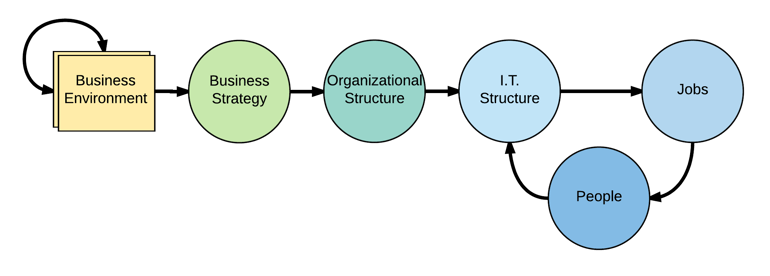It's early in the morning for a college student – just before eight a.m., when the professor strolls into the classroom, barking his customary greeting of “good morning, my little gumdrops!” He walks by the students to the front of the class, drops his armload of books on his desk, and continues straight to the whiteboard where he draws a diagram. Every lecture he draws this very same diagram in that exact spot. Some lectures it stays there, in the top-center of the left-most whiteboard, and is ignored completely – as if simply forgotten. Other lectures the professor gestures at it every few minutes, or draws arrows highlighting a specific link, or centers the entire lecture around a nuance of it. Regardless of the lecture plan, it always appears. Always. This is a rendition of what it looks like:

My attempts of scholarship have failed me, as I have been unable to attribute the flowchart to anyone; having not cited it in my class notes, and been unable to attribute it after the fact. If a reader out there is familiar with this, please write V-Soft Consulting and let us know. I call it The Barker Cycle, after that wonderful professor who instructed me, Dr. Robert Barker, Chairman of Computer Information Systems at the College of Business at the University of Louisville.
How the Barker Cycle Works
All business decision must flow through this chart. Business Strategies are built based on the business environment — what is happening in the industry. A good tool for working with this are Porter’s Five Forces: bargaining power of suppliers, bargaining power of customers, barriers to entry, threat of substitution, and competition/rivalry.
Want to talk to an expert about ServiceNow? Contact us to schedule a free 30-minute consultation here.
Building a Business Strategy
Businesses build their business strategy around the business environment and must be prepared to change when the industry does. An example of not changing with the environment could be the music industry around the turn of the millennium. The internet made sharing music easy and allowed for massive amounts of pirating. Instead of embracing the switch to digital the industry remained steadfast and lost much of its business to pirated content.
Organizational Structure
Organizational structure determines how the business strategy is put into practice. Some industries thrive in top-down control and siloed structures, but other businesses would choke and be unable to react in such a bureaucratic nightmare.
IT Structure
Also, I.T. drives policy. Policy is not explicitly mentioned in the Barker Cycle, because it both directs I.T. and is influenced by I.T. Organizational policy sets the groundwork for I.T. but it is the existence and practice of I.T. that influences the job portion of I.T. The Job portion of I.T. is called many things, such as procedure, best practices, or simply “how I do my job,” but the effect is immense. Hackman-Oldham’s theory of Job Redesign and Venkatesh’s Unified Theory of Acceptance and Use of Technology both agree that any changes to the tools used by workers need not only to make their jobs (in their eyes) easier and help them produce better results, but the new tools must empower them and give them a greater sense of purpose and ownership.
Jobs and the People (or Computers) in Them
These are hard forces to balance. Reducing the number of jobs available through automation, while keeping the new tool easy enough for older employees to use and giving them a higher perch on Maslow’s Hierarchy of Needs is often difficult to execute properly. Which leads us to people. People are affected by I.T. in not just their job descriptions, but in what people will naturally gravitate to a position, and what age demographics will prosper in that position. Older workers are more likely reject new technology, so a consequence of introducing something new is that the company may lose its most experienced, knowledgeable workers.
This is where ServiceNow comes in. When a person knows something, it is often called personal knowledge. ServiceNow incorporates tools to turn personal knowledge into as much “institutional” knowledge as possible. ServiceNow also channels policies and processes through workflows and business rules, helping to guarantee that a company’s best practices are followed, and “personal” transformed into “institutional.”

Contact an Expert
As I continue this series, I will delve into know ServiceNow achieves this through the implementation we have at V-Soft. I hope you find these articles interesting, and of use to your organization. If you have any questions or would like to request a more in-depth discussion of a point please reach out to us by clicking this link.
Other Articles In This Series
If you're interested in learning more about ServiceNow one-on-one, you can contact one of our experts for free and schedule a 30-minute consultation:















